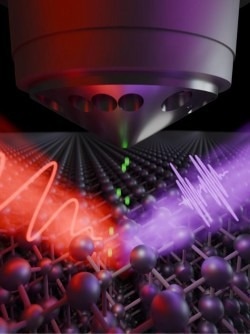The motion of electrons within a semiconductor or molecule happens on incredibly tiny time periods. Dr. Jan Vogelsang, a Physicist from the University of Oldenburg, and other researchers have now achieved noteworthy strides in their knowledge of these ultrafast processes.

Schematic representation of the experimental setup: attosecond pulses (violet) eject electrons (green) from a crystal surface. The photoemission electron microscope (cone-shaped instrument at the top) examines the rapid movements of the electrons. Image Credit: The University of Oldenburg
With previously unattainable temporal and spatial resolution in the nanometer range, the researchers used laser pulses to follow the dynamics of electrons discharged from the surface of zinc oxide crystals.
Through these studies, the group proved the practicality of a technique that may be applied, among other things, to better understand how electrons behave in nanomaterials and novel kinds of solar cells.
The study was conducted by researchers from Lund University and published in the scientific journal Advanced Physics Research. Among the researchers was Professor Dr Anne L'Huillier, who was one of the three Nobel laureates in physics from last year. The research team used attosecond physics technology in conjunction with photoemission electron microscopy (PEEM), a unique kind of electron microscopy, in their studies.
The researchers stimulated electrons with incredibly brief light pulses and observed the behavior that resulted. Vogelsang explained, “The process is much like a flash capturing a fast movement in photography.” Attoseconds are extremely brief; they are only billionths of a billionth of a second.
Combining Two Technologically Demanding Techniques
Similar experiments have not yet been able to achieve the temporal accuracy needed to trace the motion of the electrons, as the team reports. Compared to the larger and heavier atomic nuclei, the elementary particles are significantly faster at spinning around.
Despite the technological challenges, the researchers in this work managed to integrate attosecond microscopy and photoemission electron microscopy without sacrificing temporal or spatial resolution.
We have now finally reached the point where we can use attosecond pulses to investigate in detail the interaction of light and matter at the atomic level and in nanostructures.
Dr. Jan Vogelsang, Physicist, University of Oldenburg
The employment of a light source that produces an exceptionally large number of attosecond flashes per second—in this example, 200,000 light pulses per second—was one of the factors that enabled this advancement. The scientists were able to examine the behavior of the flashes without interfering with one another since each flash expelled an average of one electron from the crystal surface.
Vogelsang explained, “The more pulses per second you generate, the easier it is to extract a small measurement signal from a dataset.”
The tests for this study were conducted in Anne L'Huillier's laboratory at Lund University (Sweden). Her lab is one of the few in the world equipped with the technological tools needed for such experiments. Vogelsang is currently establishing a comparable experimental laboratory at the University of Oldenburg.
Vogelsang was a Postdoctoral Researcher at Lund University from 2017 to 2020. The two groups intend to carry out more research and investigate how electrons behave in other materials and nanostructures in the future.
Since 2022, Vogelsang has served as the Leader of the University of Oldenburg's Attosecond Microscopy research group. The esteemed Emmy Noether Programme of the German Research Foundation provides funding for the group.
Journal Reference:
Vogelsang, J., et.al., (2023). Time‐Resolved Photoemission Electron Microscopy on a ZnO Surface Using an Extreme Ultraviolet Attosecond Pulse Pair. Advanced Physics Research. doi.org/10.1002/apxr.202300122.